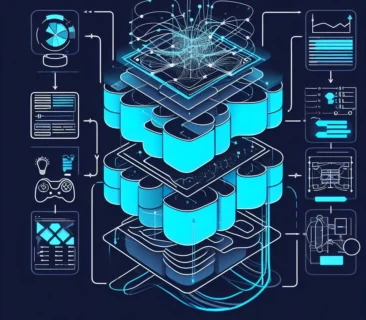Introduction:
Welcome to NextechPulse, your ultimate source for staying at the forefront of technological innovation. In today’s fast-paced world, artificial intelligence (AI) stands as a beacon of transformative progress, and at the heart of this revolution lies the enigmatic power of neural networks. In this article, we embark on a journey to unravel the pivotal role that neural networks play in driving the latest trends and advancements in AI.
Imagine machines that can learn, adapt, and make decisions just like humans. Neural networks, inspired by the intricacies of the human brain, are the driving force behind this paradigm shift. From powering cutting-edge image recognition systems to enabling conversational AI, these networks have set the stage for a new era of possibilities. As we delve deeper, we’ll explore how neural networks are shaping AI’s evolution, ushering in automation, posing ethical questions, and charting a path towards a future where technology is no longer a tool, but a collaborator.
Join us as we unlock the mysteries of neural networks, peering into the realm of deep learning, dissecting challenges, and celebrating triumphs. Together, we’ll navigate the intricate landscape of AI’s neural network-driven advancements and set our sights on the horizon of innovation.
Introduction to Neural Networks: Unraveling the Digital Brain
In the ever-expanding realm of artificial intelligence, few concepts are as captivating and essential as neural networks. At their core, neural networks are computer systems designed to simulate the learning processes of the human brain. Just as the brain’s neurons interconnect to process information, these digital counterparts utilize interconnected nodes to analyze and interpret data.
Building Blocks of Neural Networks
To understand neural networks, envision a vast web of interconnected nodes, known as artificial neurons or perceptrons. These nodes are organized into layers: an input layer, one or more hidden layers, and an output layer. Each connection between nodes, often referred to as a “synapse,” carries a weight that signifies the strength of the connection. During the learning phase, these weights are adjusted to optimize the network’s performance.
Mimicking the Learning Process
The genius of neural networks lies in their ability to learn from data. This process mirrors how humans learn from experience. Just as a child learns to distinguish between different animals by observing countless examples, a neural network learns to recognize patterns by processing vast amounts of data. Through iterative adjustments to connection weights, the network refines its understanding and enhances its accuracy.
Types of Neural Networks
Neural networks come in various architectures, each tailored to specific tasks. Convolutional Neural Networks (CNNs), for instance, excel in image recognition by applying filters to detect features like edges and textures. Recurrent Neural Networks (RNNs) specialize in sequential data, making them ideal for tasks involving language, speech, and time series analysis. The recent surge in interest has also led to advanced architectures like Transformers, revolutionizing natural language processing.
Breaking Down Complex Problems
What makes neural networks especially powerful is their ability to tackle complex problems that traditional algorithms struggle with. Tasks like language translation, facial recognition, and even autonomous driving demand a level of intricacy that conventional programming approaches can’t match. Neural networks, on the other hand, excel in finding subtle correlations and non-linear relationships within data.
A Glimpse of Future Possibilities
As we embark on this exploration of neural networks and their role in shaping AI trends, keep in mind that the journey is just beginning. The road ahead is paved with exciting prospects: neural networks could revolutionize medical diagnoses, enable personalized learning experiences, and create more intuitive human-computer interactions. However, challenges such as overfitting and ethical considerations must also be navigated to fully unlock the potential of this technology.
In the next section, we’ll dive deeper into how neural networks are driving the latest advancements in AI, transforming industries and pushing the boundaries of innovation. Stay tuned as we uncover the ways in which neural networks are propelling us into a future where machines are not just intelligent, but truly perceptive collaborators.
Driving AI Advancements: Neural Networks at the Forefront
In our quest to understand the dynamic landscape of artificial intelligence, it’s impossible to overlook the pivotal role that neural networks play in propelling the latest advancements. These intricate systems have become the cornerstone of AI research, enabling breakthroughs that were once deemed science fiction. Let’s delve into how neural networks are shaping the future by driving innovation across diverse domains.
Revolutionizing Image Recognition
The realm of image recognition has been forever transformed by the capabilities of neural networks. Convolutional Neural Networks (CNNs), a specialized type of neural network, excel at tasks like object detection, facial recognition, and even artistic style transfer. Their hierarchical architecture allows them to extract features at various levels of complexity, mimicking the human visual system.
In fields as varied as medical imaging, self-driving cars, and agriculture, CNNs are revolutionizing how we perceive and interpret visual data. This technology’s potential is limitless, from aiding doctors in diagnosing diseases to enhancing security systems through advanced surveillance techniques.
Empowering Natural Language Processing
Another frontier where neural networks shine is natural language processing (NLP). Recurrent Neural Networks (RNNs) and their successors, like Long Short-Term Memory (LSTM) networks, have given rise to language models capable of understanding context, sentiment, and even generating coherent text.
Companies are leveraging NLP-powered chatbots for customer service, sentiment analysis for brand monitoring, and language translation tools that bridge global communication gaps. Neural networks enable machines to comprehend human language nuances, making interactions with technology more natural and intuitive.
Unleashing Creativity in AI
Neural networks are not confined to utilitarian tasks; they’re also fostering creativity. Generative Adversarial Networks (GANs) are a prime example. GANs consist of two networks – a generator and a discriminator – that work in tandem to produce increasingly refined outputs. This technique has led to astonishing breakthroughs in fields like art, music, and even fashion.
GANs can create lifelike paintings, compose symphonies, and design virtual fashion collections. They represent a new era where AI transcends mere data analysis and enters the realm of artistic expression, expanding the horizons of human-machine collaboration.
Shaping Industries and Innovations
Neural networks are not just driving advancements; they’re reshaping entire industries. Healthcare is benefiting from AI-powered diagnostic tools, while finance relies on neural networks for fraud detection and algorithmic trading. Manufacturing and logistics optimize supply chains through predictive analytics, and autonomous vehicles navigate with the aid of neural networks that process vast amounts of sensor data in real-time.
In fields where data is abundant and complex, neural networks provide the means to extract valuable insights, automate decision-making, and enhance overall efficiency.
Deep Learning Unleashed: Pioneering AI Evolution
In our ongoing exploration of neural networks’ influence on AI trends, we now delve into the realm of deep learning—a groundbreaking subset that has catalyzed an unparalleled revolution. Deep learning has propelled AI to new heights by enabling machines to autonomously learn from vast datasets, revolutionizing industries and reshaping the way we perceive technology.
Foundations of Deep Learning
At the heart of deep learning are neural networks with numerous hidden layers. These networks are adept at extracting hierarchical representations of data, allowing them to discern intricate patterns and relationships that traditional models often miss. Unlike shallow models, which struggle with complex tasks, deep learning excels in tasks ranging from image and speech recognition to natural language understanding.
Unraveling Complexity with Neural Depth
The depth of neural networks grants them an extraordinary ability to process and comprehend complex information. By progressively extracting features from data, deep learning models can discern nuanced patterns, making them invaluable in deciphering intricate structures, such as identifying anomalies in medical images or predicting financial market trends.
The Data-Driven Learning Paradigm
A fundamental principle of deep learning is its reliance on vast amounts of data for training. This data-driven approach enables models to generalize from examples, uncover hidden insights, and adapt to various scenarios. The advent of big data and increased computational power has played a pivotal role in deep learning’s surge, driving innovation across industries.
From Speech to Vision: Real-World Applications
Speech recognition systems powered by deep learning have transcended mere transcription, venturing into voice assistants capable of understanding context, accents, and intent. On the visual front, deep learning has led to superhuman image recognition capabilities. This advancement aids medical professionals in diagnosing diseases from X-rays and empowers autonomous vehicles to identify pedestrians and traffic signs.
Challenges and Triumphs
Despite its prowess, deep learning isn’t without challenges. Overfitting—where models memorize data instead of generalizing—remains a concern. Researchers have addressed this by introducing regularization techniques and novel architectures. Breakthroughs such as Transformers have revolutionized natural language processing, fostering more coherent and context-aware conversations with AI.
The Road Ahead: A Learning Journey
The evolution of deep learning is ongoing, with researchers pushing boundaries in areas like self-supervised learning, reinforcement learning, and unsupervised representation learning. As models become more efficient and capable, they’re being applied to climate modeling, drug discovery, and even addressing global challenges like food security.
Neural Networks in Automation: Shaping Industries
Continuing our exploration of neural networks’ impact on the latest AI trends, we now shift our focus to their role in automation—a phenomenon that is revolutionizing industries and redefining the way we work. Neural networks, with their ability to process vast amounts of data and learn from it, are at the forefront of this transformation, driving efficiency, accuracy, and innovation.
Enhancing Efficiency and Precision
Neural networks have emerged as key players in automating complex tasks that traditionally required human intervention. Manufacturing processes, for instance, benefit from AI-driven quality control systems that detect defects with unparalleled accuracy. This not only reduces human error but also ensures products meet stringent quality standards.
In logistics, neural networks optimize supply chains by predicting demand patterns, streamlining inventory management, and even predicting potential disruptions. These automated solutions lead to cost savings, smoother operations, and enhanced customer satisfaction.
Healthcare Diagnostics and Treatment
The medical field is witnessing a seismic shift powered by neural network automation. Diagnostic imaging, such as interpreting MRI scans or identifying cancerous cells in pathology slides, is becoming more efficient and reliable. Neural networks can analyze vast databases of medical images to aid doctors in making faster, more accurate diagnoses.
Treatment planning is also benefiting from automation. AI-powered systems can recommend personalized treatment strategies based on patient data and medical research, improving patient outcomes and accelerating the development of new therapies.
Financial Insights and Decision-Making
The financial sector is leveraging neural networks to automate tasks ranging from fraud detection to algorithmic trading. Neural networks can analyze historical financial data to identify patterns that humans might overlook. This automation not only speeds up processes but also enhances decision-making by considering a broader range of variables.
Algorithmic trading, driven by neural networks, reacts to market changes in real-time, making split-second decisions that maximize profits. While this raises questions about market stability, it underscores the power of neural networks in processing vast datasets and executing complex tasks.
Autonomous Vehicles and Beyond
Neural networks are synonymous with the ongoing autonomous vehicle revolution. These networks process data from sensors, cameras, and Lidar systems to navigate and make split-second driving decisions. The automation of driving holds promise for reducing accidents, optimizing traffic flow, and increasing accessibility.
Beyond vehicles, neural networks are shaping other forms of automation, from robotic manufacturing and drone delivery to smart home systems that adapt to occupants’ preferences and behaviors.
Ethical Considerations and Future Pathways
As automation becomes more integrated into our lives, ethical considerations come to the forefront. Questions about job displacement, biased algorithms, and the implications of decision-making by AI systems require thoughtful reflection and solutions.
Looking forward, the trajectory of automation powered by neural networks seems clear. Industries will continue to adopt these technologies to increase efficiency, enhance safety, and innovate in ways that were previously unimaginable.
Conclusion:
Our journey through the realm of neural networks and their integral role in shaping the latest AI trends and advancements comes to a thought-provoking conclusion. We’ve traversed the intricate landscapes of deep learning, automation, and industry transformation, witnessing how neural networks have pushed the boundaries of what’s achievable in the realm of technology.
Neural networks have ushered in a new era where machines learn, adapt, and innovate alongside us. From deciphering complex patterns in data to driving automation across sectors, these networks are instrumental in propelling AI to new heights. As we stand at the precipice of endless possibilities, we’re reminded that with great power comes great responsibility.
The ethical considerations surrounding neural networks—the potential for bias, job displacement, and their impact on society—invite us to reflect on the path we’re charting. By addressing these challenges with foresight and collaboration, we can ensure that the transformative potential of neural networks is harnessed for the betterment of humanity.
As we bid farewell to this exploration, we encourage you to stay curious and engaged. The landscape of technology is ever-evolving, and neural networks are at the heart of this evolution. From self-driving cars to medical breakthroughs, the next wave of innovations will undoubtedly be shaped by the remarkable capabilities of neural networks. Join us as we continue to unravel the mysteries, embrace the opportunities, and navigate the complexities of the AI-powered future at NextechPulse.
References
1. LeCun, Y., Bengio, Y., & Hinton, G. (2015). Deep learning. Nature, 521(7553), 436-444.
2. Goodfellow, I., Bengio, Y., & Courville, A. (2016). Deep learning. MIT Press.
3. Krizhevsky, A., Sutskever, I., & Hinton, G. E. (2017). ImageNet classification with deep convolutional neural networks. Communications of the ACM, 60(6), 84-90.
4. Hochreiter, S., & Schmidhuber, J. (1997). Long short-term memory. Neural computation, 9(8), 1735-1780.
5. Radford, A., Metz, L., & Chintala, S. (2016). Unsupervised representation learning with deep convolutional generative adversarial networks. arXiv preprint arXiv:1511.06434.




